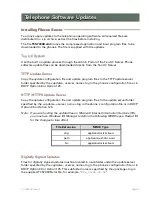
Teo IP Telephone Network Administration Guide
Page 76
13-280132 Rev. Q
the current dialed string entry matches the
<dial-pattern>
preceding the marker. A
<block-
access-marker>
at the end of the
<dial-pattern>
directs the phone to immediately cancel
the outbound call with reorder tone, if the current dialed string entry matches the
<dial-
pattern>
preceding the marker.
Prefix and suffix operations are applied at the time of call initiation, and only if the
<dial-
pattern>
matches the dialed string entry.
If the leading characters of the dialed string entry matches the prefix pattern preceding the
“|”
, then the leading characters of the dialed string entry are replaced by the substring
following the
“|”
. If the prefix pattern preceding the
“|”
is null, then the substring
following the
“|”
are inserted at the beginning of the dialed string entry. If the substring
following the
“|”
is null, then the leading characters of the dialed string entry are deleted.
If the trailing characters of the dialed string entry match the suffix pattern preceding the
“|”
, then the trailing characters of the dialed string entry are replaced by the substring
following the
“|”
and preceding any
<meta-operation>.
If the suffix pattern preceding the
“|”
is null, then the substring following the
“|”
and preceding any
<meta-operation>
are
inserted at the end of the dialed string entry. If the substring following the
“|”
and
preceding any
<meta-operation>
is null, then the trailing characters of the dialed string
entry are deleted.
M
M
e
e
t
t
a
a
O
O
p
p
e
e
r
r
a
a
t
t
i
i
o
o
n
n
s
s
Meta operations construct message headers that meet MLPP requirements.
The
<meta-operation>
includes the following combinations:
•
<priority-id>
•
<rph-id>
•
<cal-id>
•
<priority-id>
,
<cal-id>
•
<rph-id>
,
<cal-id>
If the
<suffix-operation>
includes a
<priority-id>
, then the phone displays the r-priority
identified by the second digit of the dialed string entry. If the <suffix-operation> includes an
<rph-id>
, then the phone displays the r-priority and includes a Resource Priority Header
(RPH) in the outgoing INVITE. The RPH includes the network domain identified by the
<priority-index>
and the r-priority identified by the second digit of the dialed string entry.
If the
<suffix-operation>
includes a
<cal-mode-id>
, then the phone includes a Confidential
Access Level (CAL) header in the outgoing INVITE. The CAL header includes the mode
identified by the
<cal-mode-id>
and the access level identified by the
<access-level>
.
<priority-index>
is used to select a namespace associated with
<priority-id>
and
<rph-
id>
. Predefined namespaces are selected with the following
<priority-index>
values:
•
0 selects the “dsn” namespace
•
1 selects the “q735” namespace
•
2 selects the “uc” namespace
Содержание 4101
Страница 6: ...Teo IP Telephone Network Administration Guide Page 6 13 280132 Rev Q ...
Страница 16: ...Teo IP Telephone Network Administration Guide Page 16 13 280132 Rev Q ...
Страница 18: ...Teo IP Telephone Network Administration Guide Page 18 13 280132 Rev Q ...
Страница 23: ...XML Configuration Files 13 280132 Rev Q Page 23 ...
Страница 24: ...Teo IP Telephone Network Administration Guide Page 24 13 280132 Rev Q ...
Страница 70: ...Teo IP Telephone Network Administration Guide Page 70 13 280132 Rev Q ...
Страница 72: ...Teo IP Telephone Network Administration Guide Page 72 13 280132 Rev Q ...
Страница 86: ...Teo IP Telephone Network Administration Guide Page 86 13 280132 Rev Q ...











































